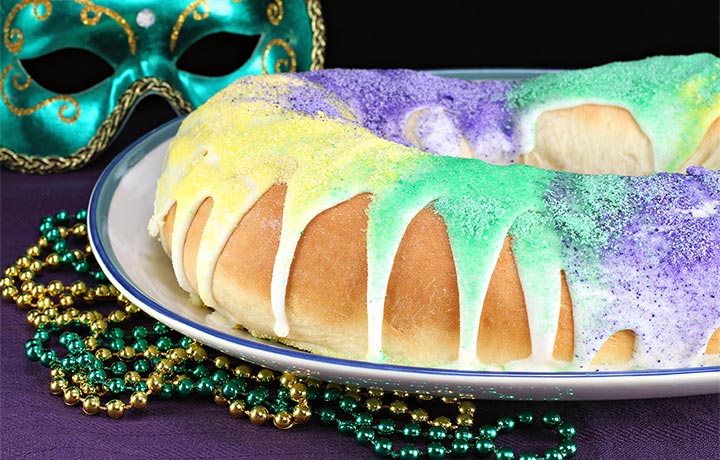The “king cake” takes its name from the biblical kings. In Western Christian liturgical tradition, the Solemnity of Epiphany—commemorated on January 6—celebrates the visit of the Magi to the Christ Child. The Eve of Epiphany (the night of January 5) is popularly known as Twelfth Night (the Twelve Days of Christmas are counted from Christmas Eve until this night). The season for king cake extends from the end of the Twelve Days of Christmas (Twelfth Night and Epiphany Day), up until the end of Shrovetide: Mardi Gras, “Fat Tuesday,” or Shrove Tuesday; the day before the start of Lent. Some organizations or groups of friends may have “king cake parties” every week through the Carnival season. In Portugal and France, whoever gets the King cake trinket is expected to buy the next cake for these get-togethers.
New Orleans
Starting on Epiphany on January 6, residents begin holding parties especially dedicated to King Cake. King Cake parties bring families and community members together to celebrate the season of Mardi Gras, with its krewe parades and festivals. King Cake is so symbolic of the Mardi Gras celebration for residents it is believed that consuming King Cake outside of the Carnival season will result in rain on Mardi Gras day. The dessert’s “search for the baby,” the small figurine located inside the cake, is a fun way for residents of New Orleans to celebrate their Christian faith.
The dessert’s significance to the city was evident in the first Mardi Gras season (2006) after Hurricane Katrina: thousands of King Cake orders flooded bakeries both inside and outside of Louisiana as displaced New Orleanians craved connection with tradition and wanted to share their Carnival culture.
Some sports teams around the area have also infused the tradition of the king cake baby into their teams. The Miami Marlins AAA minor league baseball affiliate, formerly known as the New Orleans Zephyrs, changed their name to the New Orleans Baby Cakes, starting in the 2017 season. The New Orleans Pelicans introduced the King Cake Baby as a second mascot during games around Mardi Gras, to accompany their main mascot, Pelican Pierre.
The king cake of the Louisiana tradition comes in a number of styles. The most simple, said to be the most traditional, is a ring of twisted cinnamon roll-style dough. It may be topped with icing or sugar, which may be colored to show the traditional Mardi Gras colors of green, yellow, and purple. King cakes may also be filled with additional foodstuffs, the most common being cream cheese, praline, cinnamon, or strawberry. A so-called “Zulu King Cake” has chocolate icing with a coconut filling, because the Krewe of Zulu parade’s most celebrated throw is a coconut. Some bakers now offer king cakes for other holidays that immediately surround the Mardi Gras season, such as king cakes with green and red icing for Christmas, cakes with pink and red icing for Valentine’s Day, and cakes with green and white icing for St. Patrick’s Day. Others have gone a step further and produce specialty king cakes from the beginning of football season for Louisiana State University and New Orleans Saints tailgate parties, then for Halloween, then Thanksgiving—and do not cease until after Mardi Gras season, when they produce an Easter holiday king cake.
In the Southern culture, whoever finds the trinket must provide the next king cake or host the next Mardi Gras party.
Traditional king cake baby
Traditionally, a small plastic or porcelain baby is hidden in the king cake. Originally, the baby was placed in the cake to symbolize baby Jesus. Fava beans were also used to represent Jesus.
Today, the baby symbolizes luck and prosperity to whoever finds it in his/her slice of cake. That person is also responsible for purchasing next year’s cake,[20] or for throwing the next Mardi Gras party. In some traditions, the finder of the baby is designated “king” or “queen” for the evening.
As beans and porcelain figures became replaced with plastic babies, many bakers have recently been placing the baby outside of the cake, and leaving the hiding to the customer. This is also because there is a potential of customers choking on or swallowing the baby, and bakers want to stay clear of this liability.
French king cake
The cake traditionally celebrating Epiphany in France and Quebec is sold in most bakeries during the month of January. Three versions exist: in northern France, Quebec, and Belgium the cake called galette des rois in French or Koningentaart in Flemish/Dutch (which can be either circular or rectangular) consists of flaky puff pastry layers with a dense center of frangipane or apple. In the west of France a sablé galette is made, a form of sweetcrust pastry. In southern France—Occitania, Roussillon, Provence, Catalan where it is called tortell—the cake called gâteau des rois or royaume, is a torus-shaped brioche with candied fruits and sugar, similar in its shape and colors to a crown. This later version is also common to Spain and very similar to New-Orleans king cake.
Tradition holds that the cake is “to draw the kings” to the Epiphany. A figurine, la fève, which can represent anything from a car to a cartoon character, is hidden in the cake and the person who finds the trinket in his or her slice becomes king for the day and will have to offer the next cake. Originally, la fève was literally a broad bean (fève), but it was replaced in 1870 by a variety of figurines out of porcelain or—more recently—plastic.[5] These figurines have become popular collectibles and can often be bought separately. Individual bakeries may offer a specialized line of fèves depicting diverse themes from great works of art to classic movie stars and popular cartoon characters. The cakes are usually sold in special bags, some of which can be used to heat the cake in a microwave without ruining the crispness of the cake. A paper crown is included with the cake to crown the “king” who finds the fève in their piece of cake. To ensure a random distribution of the cake shares, it is traditional for the youngest person to place him- or herself under the table and name the recipient of the share which is indicated by the person in charge of the service.
Formerly, the cake was divided into as many shares as there were guests, plus one. The latter, called “the share of God,” “share of the Virgin Mary,” or “share of the poor” was intended for the first poor person to arrive at the home.

